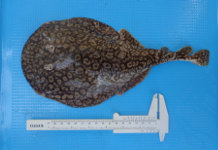Narcine leoparda
Carvalho, 2001
Classification: Elasmobranchii Torpediniformes Narcinidae
Reference of the original description
A new species of electric ray, Narcine leoparda, from the tropical eastern Pacific Ocean (Chondrichthyes: Torpediniformes: Narcinidae). Proceedings of the Biological Society of Washington, 114(3), 561–573
A new species of electric ray, Narcine leoparda, from the tropical eastern Pacific Ocean (Chondrichthyes: Torpediniformes: Narcinidae). Proceedings of the Biological Society of Washington, 114(3), 561–573
Image of the original description
Image in copyright.
Image in copyright.
Types
Narcine leoparda
Holotype: USNM: 222200; Paratype: USNM: 222500; USNM: 222498; USNM: 222199; USNM: 222198; USNM: 235519;
Narcine leoparda
Holotype: USNM: 222200; Paratype: USNM: 222500; USNM: 222498; USNM: 222199; USNM: 222198; USNM: 235519;
Description :
Citation: Narcine leoparda Carvalho, 2001: In: Database of modern sharks, rays and chimaeras, www.shark-references.com, World Wide Web electronic publication, Version 01/2026
Please send your images of "Narcine leoparda" to info@shark-references.com

Narcine leoparda Carvalho, 2001, eastern Pacific © Maribel Carrera

Narcine leoparda Carvalho, 2001, eastern Pacific © Maribel Carrera
Short Description
Original diagnosis after CARVALHO, 2001 [3832]: A species of Narcine distiguished from all others by its unique dorsal coloration composed of numerous small white to creamy-white spots and/or ocelli on disc and dorsal and caudal fins, over a reddish-brown or brown background. Additional characters that in combination diagnose this new species include: tail length shorter than disc width or length, upper and lower external tooth bands subequal in width, spiracles with smooth rims devoid of external papillae, second dorsal fin usually slightly larger than first in both height and length of base, and lateral tail folds originating under level of first dorsal fin base.
Original diagnosis after CARVALHO, 2001 [3832]: A species of Narcine distiguished from all others by its unique dorsal coloration composed of numerous small white to creamy-white spots and/or ocelli on disc and dorsal and caudal fins, over a reddish-brown or brown background. Additional characters that in combination diagnose this new species include: tail length shorter than disc width or length, upper and lower external tooth bands subequal in width, spiracles with smooth rims devoid of external papillae, second dorsal fin usually slightly larger than first in both height and length of base, and lateral tail folds originating under level of first dorsal fin base.
Distribution
Southeast Pacific: Colombia [3832]; first record (2015): [22369]: off the coast of Manta, Ecuador; (2015): [23609]: Manta and Bahía de Caráquez, Ecuador; Source: www.gbif.org
Southeast Pacific: Colombia [3832]; first record (2015): [22369]: off the coast of Manta, Ecuador; (2015): [23609]: Manta and Bahía de Caráquez, Ecuador; Source: www.gbif.org
Dentition
Original diagnose after CARVALHO, 2001 [3832]: Teeth in 12/8-16/12 exposed rows in specimens about 17 5 mm total length or larger, but a 146 mm total length female has 11/13 exposed teeth rows. Teeth relatively small, set in quincunx arrangement and with single, sharp cusp, even on small specimens (e.g., 146 mm TL specimen); inner rows with very sharp teeth. Crowns wider-than-long at bases; tooth bases roughly sub-circular.
Original diagnose after CARVALHO, 2001 [3832]: Teeth in 12/8-16/12 exposed rows in specimens about 17 5 mm total length or larger, but a 146 mm total length female has 11/13 exposed teeth rows. Teeth relatively small, set in quincunx arrangement and with single, sharp cusp, even on small specimens (e.g., 146 mm TL specimen); inner rows with very sharp teeth. Crowns wider-than-long at bases; tooth bases roughly sub-circular.
Remarks
shark-references Species-ID=4038;
shark-references Species-ID=4038;

















